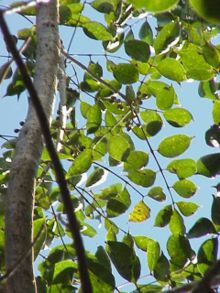BURSERA
Bursera, (Bursera delpechiana)
belonging to the family Burseraceae, introduced to India from Mexico in
1920. The natives of Mexico called this tree as linaloe and Indian lavender
tree and the oil as linaloe oil.
In Mexico,
linaloe oil is distilled both from the wood and berries of wild trees. The
characteristic sweet odour of the Mexican linaloe wood oil blends ever with
lilac, jasmine and most other floral bouquets The Indian oil is superior in
quality compared to the Mexican oil.
The main constituent of Mexican
linaloe oil is linalool (60-70%).
The different parts of the plant from
which the oil is extracted with their percentage are; foliage - 0.13-0.3 per
cent, mature heart wood - 7-9 per cent - India, 2.5-3.0 per cent - Mexico,
green fruits - 2 per cent, shade dried husk of picked berries - 10.0-14.0 per
cent, shade dried husk of fallen berries - 14-18 per cent and roots - 0.27 per
cent.
Description of
the plant
Bursera is a large deciduous tree.
Male tree is medium sized, has a longer trunk and grows to about 7.5 m.
Inflore-scence is a paniculate cyme with pubescent axis upto 10 cm long and
contains 40-50 staminate flowers. female
tree attains about 6 m height and has larger leaves and some of them are 18 cm
long. Leaves are imparipinnate, serrate or nearly entire.
The
inflorescence contains 8-20 pistillate flowers. Flowers are green, pentamerous;
calyx small, lobes rounded, petals valvate in bud, stamens 10, nearly equal,
ovary hairy sourrounded by a broad crenate disk. Fruit is a fleshy berry, a
little larger than a pea, about 1 cm in diameter, dark green in colour turning
to a reddish brown as they mature and fall off.
Species/Varieties
1. Bursera
gumifera American gum tree' or Indian birch or birds
tree.
2. Bursera
icilarita Tree bears
edible aromatic fruits.
3. Bursera
javanica Jawness of
the leaves and fruits.
4. Bursera
leptopholes Mature
fruits are edible
5. Bursera
serratea Pulp is
edible and also yield essential oil.
6. Bursera
simaruba Commonly called Rumb or `West Indian birch';
7. Bursera
penicilliata Every plant part contains essential oil
8. Bursera
kluggis Yield
triterpenes which have anticancer activity

No comments:
Post a Comment